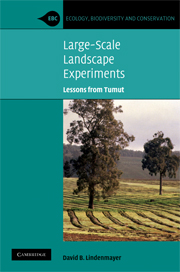Book contents
- Frontmatter
- Contents
- Preface
- Acknowledgements
- 1 The science of understanding landscape change: setting the scene for the Tumut Fragmentation Study
- 2 The theory: an overview of landscape change and habitat fragmentation
- 3 The field laboratory: the Tumut study area and the vertebrate animals it supports
- 4 Setting up the study: the design and implementation of the main cross-sectional study at Tumut
- 5 The core findings: the effects of landscape context on animals and plants
- 6 Patch use: how animals use patches of remnant eucalypt forest surrounded by pine
- 7 Theory against data: testing ecological theories and concepts
- 8 Testing PVA models with real data: melding demographic work with population modelling
- 9 Genes in the landscape: integrating genetic and demographic analyses
- 10 Refining and extending the research programme: additional studies at Tumut (and nearby) that build on the Fragmentation Study
- 11 Recommendations for plantation managers: implications for biodiversity and conservation in plantations
- 12 Lessons on running large-scale research studies: some insights from running the Tumut Fragmentation Study and directions for the future
- Appendix 1 List of collaborators/contributors to the Tumut Fragmentation Experiment
- Appendix 2 Detections of bird species in the Tumut Fragmentation Study classified by four broad classes of sites
- References
- Index
2 - The theory: an overview of landscape change and habitat fragmentation
Published online by Cambridge University Press: 20 May 2010
- Frontmatter
- Contents
- Preface
- Acknowledgements
- 1 The science of understanding landscape change: setting the scene for the Tumut Fragmentation Study
- 2 The theory: an overview of landscape change and habitat fragmentation
- 3 The field laboratory: the Tumut study area and the vertebrate animals it supports
- 4 Setting up the study: the design and implementation of the main cross-sectional study at Tumut
- 5 The core findings: the effects of landscape context on animals and plants
- 6 Patch use: how animals use patches of remnant eucalypt forest surrounded by pine
- 7 Theory against data: testing ecological theories and concepts
- 8 Testing PVA models with real data: melding demographic work with population modelling
- 9 Genes in the landscape: integrating genetic and demographic analyses
- 10 Refining and extending the research programme: additional studies at Tumut (and nearby) that build on the Fragmentation Study
- 11 Recommendations for plantation managers: implications for biodiversity and conservation in plantations
- 12 Lessons on running large-scale research studies: some insights from running the Tumut Fragmentation Study and directions for the future
- Appendix 1 List of collaborators/contributors to the Tumut Fragmentation Experiment
- Appendix 2 Detections of bird species in the Tumut Fragmentation Study classified by four broad classes of sites
- References
- Index
Summary
A vast array of topics fall under the umbrella of landscape modification and habitat fragmentation. These include (but are not limited to): conceptual models of landscape cover, habitat loss, habitat degradation, habitat subdivision, edge effects, connectivity, metapopulation dynamics, landscape heterogeneity, threshold effects, extinction cascades, nestedness of biotic assemblages, patch size relationships and landscape genetics. These topics are strongly interrelated and boundaries between them are somewhat artificial (Lindenmayer et al.,2007a) (Figure 2.1).
Many of the individual topics shown in Figure 2.1 have been reviewed in depth over the past two decades, such as connectivity (Bennett, 1990, 1998, Hilty et al., 2006) and edges (Ries et al., 2004; Harper et al., 2005). There also have been major overarching reviews of landscape modification and habitat fragmentation per se (Saunders et al., 1991; Zuidema et al., 1996; Fahrig, 2003; Hobbs and Yates, 2003, Lindenmayer and Fischer, 2006; Fischer and Lindenmayer, 2007). The aim of this chapter is not to produce yet another focused review of a particular topic or of the massively increasing body of work on landscape change and habitat fragmentation; rather, it is to provide brief summaries of topics that were tackled as part of the work at Tumut. These summaries therefore prepare the ground for subsequent chapters that describe the research findings from Tumut.
The ‘species-orientated’ to ‘patterns-based’ continuum
Landscape modification and habitat fragmentation can produce a wide range of effects across several spatial scales and levels of biological organisation.
- Type
- Chapter
- Information
- Large-Scale Landscape ExperimentsLessons from Tumut, pp. 9 - 38Publisher: Cambridge University PressPrint publication year: 2009



